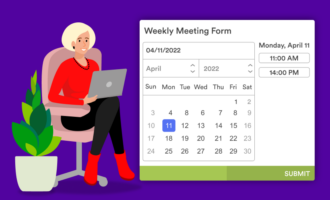Tips for effectively manage remote teams
- Maintain your one-on-one meetings
- Strike a healthy balance of supervision and trust
- Document your processes
- Choose the right remote project management system
Though COVID-19 affected every facet of our lives — where we ate, when we saw family and friends, and how we celebrated milestone events — it altered the way we work most of all. When the pandemic started, many people said goodbye to tight cubicles, overcrowded convention weekends, and holiday parties and hello to video conference meetings, mile-long email threads, and kids and pets howling in the background of every business call.
On the bright side for both employers and employees, remote work can provide better work-life balance, less stress from office politics and long commutes, and, surprisingly, greater productivity. It’s also less expensive for employers, whether because of savings on rent, building maintenance, mileage reimbursement, and relocation fees for new employees or because of less absenteeism and turnover.
However, remote work and remote project management are not without their challenges, especially for supervisors who still have to manage employees, workloads, schedules, and interdepartmental communication. And with various types of remote team setups — some companies are fully remote while others implement a flex or hybrid system — juggling it all only proves more difficult.
Fortunately, there are ways to streamline the remote project management process.
How to effectively manage remote teams
Here are four tips for overseeing employees and projects remotely while staying sane.
1. Maintain your one-on-one meetings
If your company is totally or partially remote, some of the most important meetings to keep are your one-on-ones with your direct reports. By regularly checking in with your employees, you can discuss issues they’re facing, provide beneficial feedback to keep them motivated, offer any guidance or assistance to help combat their project struggles, and, overall, build stronger, more trusting relationships with your team members.
Though you should ideally schedule one-on-ones weekly to ensure you keep productivity flowing and goals aligned, biweekly or monthly meetings are acceptable, too, especially if you oversee a significant number of employees or ventures. What’s more, routine check-ins often eliminate the need for unnecessary meetings — or, worse yet, miscommunication and misunderstandings — which can translate into increased productivity and fewer preventable errors.
2. Strike a healthy balance of supervision and trust
Though it may seem like a stretch, some people think micromanaging is a bit like bullying, as both take a similar toll on their victims: increased stress, lack of motivation, and both physical and mental health issues. And with finicky, perfectionist managers watching employees’ every move, it’s easy to see why 69 percent of workers in a recent Trinity Solutions survey said they’ve thought about looking for a new job to get away from micromanagers. (And 36 percent of them actually did decide to escape a micromanager by taking a new job.)
But, as a manager, you do have a job to do. If some of your team members aren’t pulling their weight, here are some things you can do to improve the situation:
- Set expectations: Provide clear instruction to your employees about exactly what you need from them, including realistic and attainable objectives and deadlines.
- Be more flexible: Everyone has different working styles and personal and professional commitments, so if your company permits it, see if you can let your employees dictate their schedules a bit more (as long as they complete their work, of course).
- Delegate: More often than not, micromanaging stems from perfectionism and knowing (or thinking) you can accomplish a task better and more efficiently. Instead, try focusing on big picture items and removing projects from your plate that someone else can easily handle.
- Trust them: At the end of the day, sometimes all you can do is trust the people around you to do their jobs and do them well, especially if your company has trained them properly and given them all the tools they need to get things done.
3. Document your processes
While most companies have their entire onboarding process digitized to help newcomers get started, that’s usually one of the few, if not the only, fully documented business practices. Yet, as remote project management continues to gain popularity, it’s not only wise to document everything — from FAQs about the organization and company culture to content style and training resources — it’s also necessary to staying organized and aligned throughout the company.
By creating “living” documents that are consistently updated, you can help keep everyone on the same page, no matter where they live, which department they work in, or how long they’ve been with the company.
4. Choose the right remote project management system
One of the best, most efficient ways to manage your employees and their workloads virtually is by implementing an automated remote project management system. One solution is online form builder Jotform.
Through one database, you can manage your team by collecting employee and project data with forms (such as timesheets and end-of-day reports) that can automatically update spreadsheets (like task lists and project trackers). You can either work from Jotform’s catalog of customizable forms and table templates, or you can create them from scratch.
When it comes to remote project management, patience is key. Remote work is still a relatively new concept for many companies, and it’s not going anywhere anytime soon. In fact, Upwork predicts that by 2025, 22 percent of the American workforce, or 36.2 million people, will be working remotely.
If you give yourself — and your employees — some room to communicate, make improvements, and create better, more effective processes together, you’ll be successful, no matter where everyone’s located.
Photo by cottonbro studio

















































Send Comment: